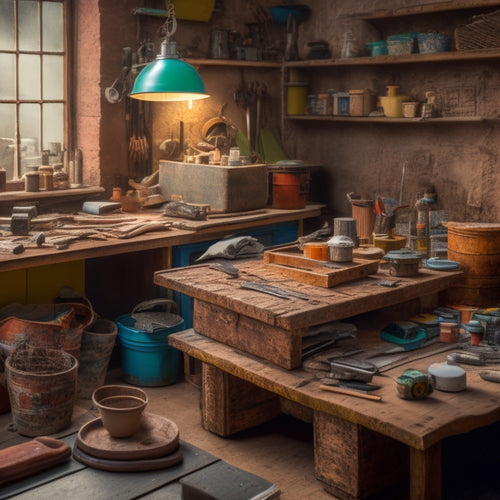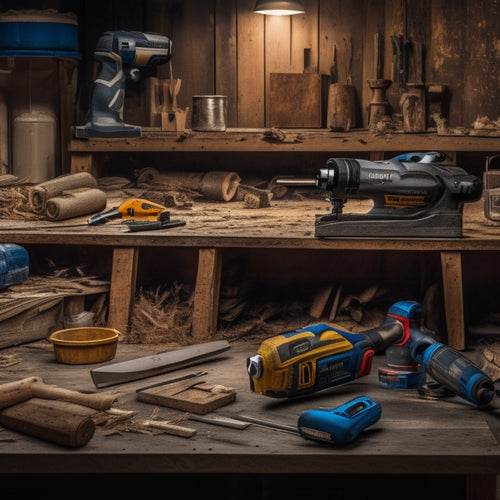
3 Crucial Tools for Block Home Renovation
Share
You'll need to master three critical tools to guarantee a successful block home renovation: a tamping tool for a stable foundation, a precision leveling tool for perfect alignment, and a cutting and chiseling system for accurate block fitting. A tamping tool guarantees stable and even foundations, preventing uneven settling and structural issues. Leveling tools, such as spirit levels and laser levels, help you achieve perfect horizontal and vertical alignment. Cutting and chiseling tools, like diamond blade saws and flat chisels, enable you to fit blocks together with precision. By understanding how to use these tools effectively, you'll be well on your way to a successful renovation.
Key Takeaways
• A tamping tool is essential for ensuring a stable and even foundation for concrete blocks, preventing uneven settling and structural issues.
• A level is crucial for achieving perfect horizontal and vertical alignment, critical for the structural integrity of block construction.
• A diamond blade saw is recommended for dry cutting concrete blocks, while a tile nipper is ideal for plunge cutting.
• A plate compactor or hand tamper is necessary for compacting soil and preventing settling, especially for small to medium-sized projects.
• Chisels, such as flat, round, or pointed, are vital for cutting and shaping concrete blocks to fit specific spaces and designs.
Essential Tamping Tool for Block
When laying concrete blocks, you'll need a reliable tamping tool to guarantee a stable and even foundation. A tamping tool is essential for achieving proper soil compaction, which is critical for the structural integrity of your block construction.
Without proper compaction, your blocks may settle unevenly, leading to cracks and instability.
To master tamping techniques, start by selecting the right tool for the job. A hand tamper or plate compactor is ideal for small to medium-sized projects, while a ride-on compactor is better suited for larger areas.
Next, prepare the soil by clearing debris and compacting the ground in sections. Apply gentle to moderate pressure, depending on the soil type and moisture level, to achieve the best compaction.
As you lay each block, use your tamping tool to make sure the soil is compacted firmly beneath it. This will prevent settling and ensure a level surface.
Level and Alignment Mastery
With your foundation firmly in place, you're now ready to focus on achieving perfect level and alignment, as even the slightest deviation can compromise the structural integrity of your block construction.
To guarantee precision, you'll need to master block leveling techniques that assure accurate horizontal and vertical alignment.
Invest in alignment precision tools, such as spirit levels, laser levels, and precision squares, to guarantee your blocks are perfectly aligned. These tools will help you detect even the slightest deviations, allowing you to make adjustments before they become major issues.
When working with blocks, it's crucial to check the level and alignment regularly, as even minor mistakes can accumulate and lead to significant problems down the line.
Cutting and Chiseling Mastery
Master the art of cutting and chiseling blocks to precise dimensions by selecting the right tools and techniques, ensuring a snug fit and a professional finish.
When it comes to cutting techniques, you'll want to familiarize yourself with different methods, such as dry cutting, wet cutting, and plunge cutting. Each technique serves a specific purpose and requires the right tool for the job. For instance, a diamond blade saw is ideal for dry cutting, while a tile nipper is better suited for plunge cutting.
When it comes to chisel types, you'll need to choose the right one for the task at hand. There are several chisel types, including flat, round, and pointed chisels. Flat chisels are great for removing small amounts of material, while round chisels are better for curved cuts. Pointed chisels, on the other hand, are ideal for detailed work and removing old mortar.
Frequently Asked Questions
What Safety Gear Is Necessary for Block Home Renovation Projects?
When tackling a block home renovation project, you'll need to prioritize your safety above all else.
You're working with heavy materials and power tools, which can be hazardous if you're not properly equipped.
You'll need safety goggles to shield your eyes from debris and dust, and protective gloves to prevent cuts and abrasions on your hands.
Don't even think about starting the project without these essential safety gear - your well-being depends on it.
Can I Reuse Old Mortar During the Renovation Process?
As you ponder reusing old mortar, you're taking a risk that could compromise your entire renovation project.
The truth is, old mortar can be a breeding ground for contaminants, affecting the bond between new blocks and the old mortar.
You must consider the type of mortar used initially and its application method.
If it's a lime-based mortar, it might be reusable, but if it's a cement-based mortar, it's best to err on the side of caution and start fresh to guarantee a strong, durable bond.
How Do I Handle Unexpected Structural Damage Discoveries?
When you uncover unexpected structural damage during renovation, don't panic.
You'll need to conduct a thorough structural inspection to assess the extent of the damage. This will help you identify the root cause and determine the necessary repairs.
A thorough damage assessment will guide your next steps, ensuring you address the issue effectively and safely.
It's essential to prioritize this process to avoid further damage or even collapse.
What Permits Are Required for Major Block Home Renovations?
You're about to unearth a treasure trove of permits!
When tackling major block home renovations, you'll need to navigate a sea of paperwork to guarantee compliance with local building codes.
Don't let it overwhelm you - prioritize permits for electrical, plumbing, and structural work to avoid delays.
Remember, a single misstep can set your renovation timelines back by months.
Get familiar with local regulations and submit applications well in advance to keep your project on track.
Can I DIY Block Home Renovation or Hire a Professional?
When deciding between DIY and hiring a pro for your block home renovation, consider your skills and the project's complexity.
If you're comfortable with demo, construction, and installation, DIY might be a cost-effective option, offering advantages like flexibility and pride of ownership.
However, if you're unsure or lack experience, hiring a professional brings expertise, ensuring code compliance and quality workmanship, which may be worth the investment.
Conclusion
As you stand amidst the rubble of your block home renovation, remember that the right tools are the master keys that release a sturdy, long-lasting structure.
With the essential tamping tool, level, and cutting and chiseling tools, you'll be the conductor orchestrating a symphony of precision and perfection.
As the dust settles, your renovated block home will rise like a phoenix from the ashes, a proof of your mastery of the craft.
Related Posts
-

Budget-Friendly Materials for Your Home Renovation Project
As you plan your home renovation project, finding budget-friendly materials is key to turning your design vision into...
-

Why Renovation Waste Disposal Harms the Environment
When you undertake a renovation project, you're contributing to a staggering problem: renovation waste disposal, whic...
-

10 Best Power Tools to Buy for Home Renovation
To tackle your home renovation project efficiently, you'll need the right power tools for the job. A cordless drill f...


